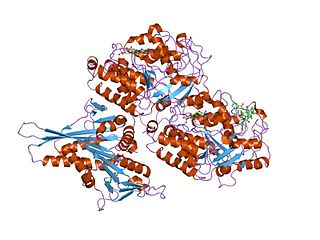
Tubulin in molecular biology can refer either to the tubulin protein superfamily of globular proteins, or one of the member proteins of that superfamily. α- and β-tubulins polymerize into microtubules, a major component of the eukaryotic cytoskeleton. Microtubules function in many essential cellular processes, including mitosis. Tubulin-binding drugs kill cancerous cells by inhibiting microtubule dynamics, which are required for DNA segregation and therefore cell division.

Treponema is a genus of spiral-shaped bacteria. The major treponeme species of human pathogens is Treponema pallidum, whose subspecies are responsible for diseases such as syphilis, bejel, and yaws. Treponema carateum is the cause of pinta. Treponema paraluiscuniculi is associated with syphilis in rabbits. Treponema succinifaciens has been found in the gut microbiome of traditional rural human populations.

The Spirochaetales are an order of spirochete bacteria. Some species within this order are known to causes syphilis, Lyme disease, relapsing fever, and other illnesses.

The Leptospiraceae are a family of spirochete bacteria. It includes the genus Leptospira which contains some pathogenic species.
Atopobium is a genus of Actinomycetota, in the family Coriobacteriaceae. Atopobium species are anaerobic, Gram-positive rod-shaped or elliptical bacteria found as single elements or in pairs or short chains.
The Halanaerobiales are an order of bacteria placed within the class Clostridia, and encompassing two families, the Halanaerobiaceae and the Halobacteroidaceae. Originally placed within the highly polyphyletic class Clostridia, according to the NCBI and LPSN, it is now thought to lie outside the Bacillota. Halanaerobiales are halophilic obligate anaerobes with a fermentative or homoacetogenic metabolism.
Desulfovibrio is a genus of Gram-negative sulfate-reducing bacteria. Desulfovibrio species are commonly found in aquatic environments with high levels of organic material, as well as in water-logged soils, and form major community members of extreme oligotrophic habitats such as deep granitic fractured rock aquifers.
Parachlamydiaceae is a family of bacteria in the order Chlamydiales. Species in this family have a Chlamydia–like cycle of replication and their ribosomal RNA genes are 80–90% identical to ribosomal genes in the Chlamydiaceae. The Parachlamydiaceae naturally infect amoebae and can be grown in cultured Vero cells. The Parachlamydiaceae are not recognized by monoclonal antibodies that detect Chlamydiaceae lipopolysaccharide.

In the taxonomy of microorganisms, the Methanomicrobia are a class of the Euryarchaeota.
Thermoproteales are an order of archaeans in the class Thermoprotei. They are the only organisms known to lack the SSB proteins, instead possessing the protein ThermoDBP that has displaced them. The rRNA genes of these organisms contain multiple introns, which can be homing endonuclease encoding genes, and their presence can impact the binding of "universal" 16S rRNA primers often used in environmental sequencing surveys.
The Negativicutes are a class of bacteria in the phylum Bacillota, whose members have a peculiar cell wall with a lipopolysaccharide outer membrane which stains gram-negative, unlike most other members of the Bacillota. Although several neighbouring Clostridia species also stain gram-negative, the proteins responsible for the unusual diderm structure of the Negativicutes may have actually been laterally acquired from Pseudomonadota. Additional research is required to confirm the origin of the diderm cell envelope in the Negativicutes.
The Selenomonadales are an order of bacteria within the class Negativicutes; unlike most other members of Bacillota, they are Gram-negative. The phylogeny of this order was initially determined by 16S rRNA comparisons. More recently, molecular markers in the form of conserved signature indels (CSIs) have been found specific for all Selenomonadales species. On the basis of these markers, the Selenomonadales are inclusive of two distinct families, and are no longer the sole order within the Negativicutes. Several CSIs have also been found specific for both families, Sporomusaceae and Selenomonadceae. Samples of bacterial strains within this order have been isolated from the root canals of healthy human teeth.
Moorella is a genus of bacteria belonging to the phylum Bacillota.

The Syntrophomonadaceae are a family of anaerobic bacteria in the order of Clostridiales. As a source of energy, these organisms uses carboxylic acids.
Phycisphaeraceae is a family of bacteria.
Bacteriovoracaceae is a family of gram-negative, comma-shaped bacteria. All members have a two-part life cycle consisting of a free-living motile "attack phase" and a "predatory phase" that lives in the periplasm of other gram-negative bacteria. Bacteriovoracaceae are found in freshwater and in the soil.
Halanaerobium is a gram-negative, non-endospore-forming, rod-shaped, and strictly anaerobic genus of bacteria from the family Halanaerobiaceae.
Euzebya is a genus of Gram-positive bacteria.
Isosphaeraceae is a family of bacteria.
The Pirellulaceae are a family of bacteria.





